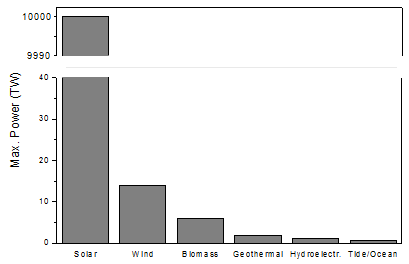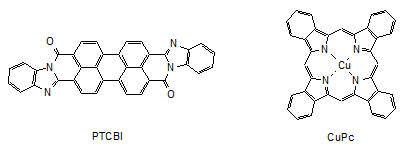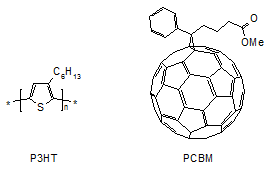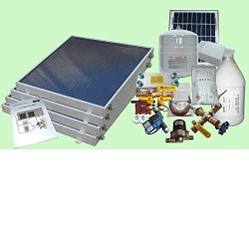In the past hundred years, human population quadrupled to almost seven billion inhabitants and with it, the global energy consumption increased sixteen fold. The limited supply of today’s main energy sources – oil, coal and uranium – will soon force us to replace most of the currently used power plants by renewable energy sources like wind-, hydroelectric- and solar power systems. With a power of 10000 TW on the surface of the Earth, the amount of energy provided by the sun is enormous and the comparison to the second largest renewable energy source, wind power (14 TW), clearly points out the importance of solar energy. With an average power conversion efficiency of 10%, solar panels covering only 0.08% of the surface of the Earth would provide the world’s current consumption rate of energy (10 TW).

Organic Solar Cells
by Simon
Organic solar cells have the potential to become a flexible and low-cost alternative to their silicon-based counterparts and are today on the brink of industrial mass production.
 Renewable energies in comparison |
At present, solar cells comprising an inorganic semiconductor such as mono- or multi-crystalline silicon, have record power conversion efficiencies close to 39%, while commercially available solar panels show a significantly lower conversion of around 15–20%. Yet, the production of these devices requires several energy intensive processes at high temperatures up to 1400 °C, leading to high manufacturing costs. In this respect, organic solar cells are very attractive, since only thin films of relatively cheap materials are needed, thus enabling low-cost roll-to-roll fabrication. Additionally, organic photovoltaics can be prepared on flexible substrates like plastic films, enabling completely new fields of application.
First steps into the organic field
The first organic semiconductors with reasonable conductivity were reported in the 1950s and initial attempts in the field of organic solar cells date back to 1959. Kallman and Pope discovered that anthracene can be used to make a photovoltaic device, but their single layer architecture provided a photovoltage of only 0.2 V with an extremely low efficiency. In quick succession advances were made and a first breakthrough was presented in 1986 by Tang et al.: Perylene-3,4,9,10-tetracarboxyl-bis-benzimidazole (PTCBI) and copper phthalocyanine (CuPc) were evaporated in a two layer arrangement onto a transparent electrode, resulting in the first bilayer heterojunction solar cell with a power conversion efficiency of ca. 1%.
 The first (working) organic solar cell containing phtalocyanine and PTCBI as active materials |
Recent advances
At present, one of the most studied photoactive materials is poly(3-hexylthiophene) (P3HT). Used as donor in solution processed bulk heterojunction solar cells (BHJSC) with [6,6]-phenyl-C61-butyric acid methyl ester (PCBM) as acceptor, a certified power conversion efficiency of over 5% with an external quantum yield of up to 88% was achieved (Figure 3). In particular, its crystalline morphology in the solid state with almost ideal HOMO and LUMO energy levels makes P3HT a pristine material for polymer solar cells.
 P3HT and fullerene-based PCBM |
Various approaches have been employed to achieve higher power conversion efficiencies and currently, both “small molecule” and polymer organic solar cells have already achieved power conversions of more than 8%. Research in this field is highly active all over the world and first examples of organic solar cells are already applied in some consumer goods.
 The sun - Indefinite power supply |
You might also like
Going to Solar Power by Taking the First Affordable StepThe easiest way to start converting to solar power is to start with one or mo...
Solar Energy: The Details You Want to KnowSolar Power has many details you should know before maling a decision to add ...



 Best resources for copyright free imageson 03/23/2012
Best resources for copyright free imageson 03/23/2012


Comments
I'm in the both camp, the needs are as diverse as organic and nano, which will cover separate needs. Let the ideas and developments flow! Great Read :)
I try to be energy conscious. In other words I'm always looking for ways to save money on energy costs. Thanks for this.
This is a new topic for me. One vote up.
Thanks for your comments!
Probably, each type/technology will have its own domain to excel. Organics for example will never work for NASA, but they will most likely do a great job for private/custom applications ...
Fascinating. Hubby says it wil be interesting to see what eventually wins out; organic, thin film semi, or some nano technology hybrid.
A bit beyond my limited intellectual capacities, but, I do think it is the way to go.
This is the first I've heard of organic solar cells. I hope to hear more about them, so hopefully they'll become mainstream.
This is something that I would like to learn more about. Thanks for the info!
Let the sunshine in! :)